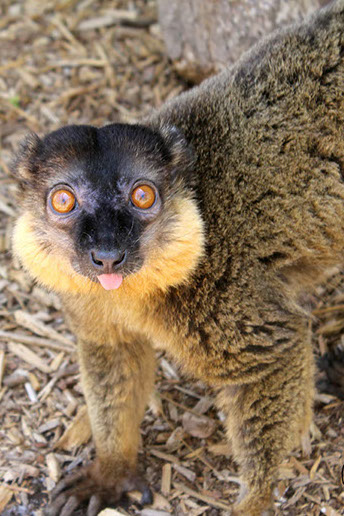Collared Brown Lemur
Eulemur collaris
Conservation status
Endangered (IUCN Red List, 2020)
Family
Lemuridae
What they look like
These medium-sized lemurs, also called red-collared brown lemurs, weigh in at 2.25 to 2.5 kilograms (5 to 5.5 pounds). Their “balancing tails” are longer than their bodies. Males and females exhibit different coloring except in the eyes, which are orange-red. Males have more gray in their rufous brown coats, darker tails, and a dark stripe along the spine. The top of their heads, muzzles, and faces are dark gray or black, which contrasts with their bushy reddish-brown cheeks and beards. Females also have a lighter gray coloration on their heads and faces. Females also have reddish-brown cheeks, but they are less prominent than in the males.
Where they live
Collared lemurs inhabit tropical moist lowland and montane forests in southeastern Madagascar. They can easily be seen in the protected areas of Andohahela National Park and Midongy du Sud National Park.
What they eat
Collared lemurs eat mostly fruit, which makes up 71% of their diet in the wild. This frugivorous diet is broadly supplemented with flowers and nectar, bark, soil, insects and even small chameleons. 75 plant food species have been documented. Because their diet contains so much fruit, they may be critical seed dispersers, and may also pollinate Ravenala trees.
How they behave
Collared lemurs are understudied but appear to live in mixed-sex social groups ranging in size from 3 to more than a dozen individuals, with troops as large as 22. These social animals forage together high in the rainforest canopy and rarely come to the ground. When groups overlap, noisy, hostile encounters may ensue. Collared lemurs appear to be active day and night (cathemeral). Female dominance has not been observed.
How they reproduce
Females are sexually receptive (estrus) for only a 24-hour period between May and July, and give birth about 120 days later in September/October. Males fight aggressively during the mating season, and some may be expelled from the group.
What threats they face
Collared brown lemurs are threatened by habitat loss due to slash-and-burn agriculture, charcoal production, timber extraction and other forms of forest clearance. They are also hunted widely as a food source.
Collared brown lemurs at LCF’s Florida reserve
Collared lemur infants are born between March and June, six months earlier than in Madagascar. Since LCF is located in the northern hemisphere, breeding season experiences a 6-month shift in timing from Madagascar (which is located in the southern hemisphere).
